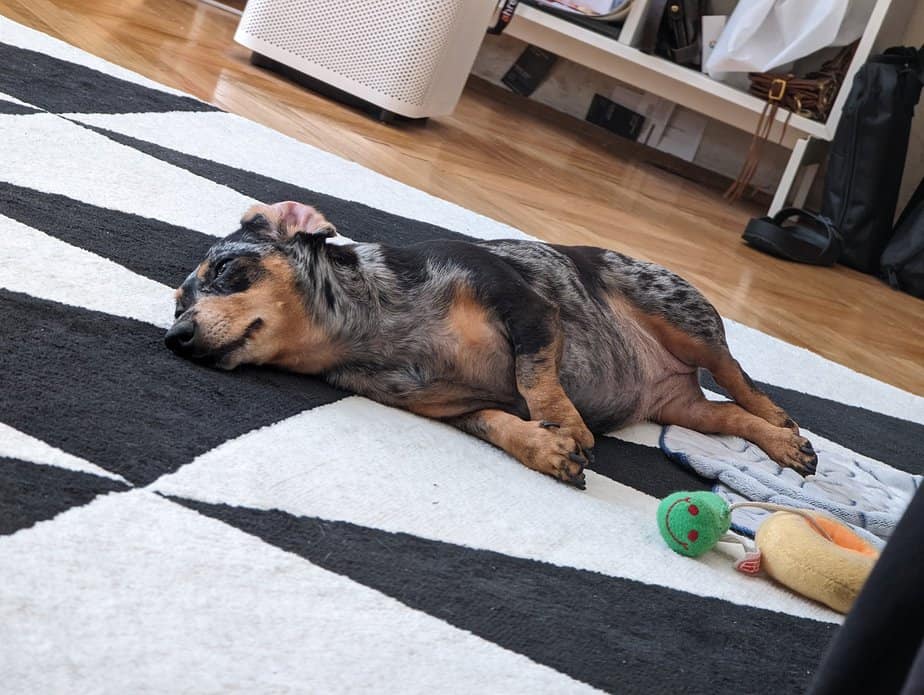Dogs are known for their loyalty and companionship, but many of them struggle with separation anxiety. This is actually something that Mocsing, our mini Dachshund (the bread is actually notorious for suffering from this) has always been struggling with.
This condition can cause immense distress and discomfort for both dogs and their owners. It breaks our hearts when we have to let Mocsing at home… But we can’t always take her with us.
Understanding what separation anxiety is, its symptoms, and how to address it can help create a more peaceful and harmonious environment for our four-legged friends. In this article, we will explore various aspects of separation anxiety in dogs and provide valuable insights into managing and treating this common issue.
What is Dog Separation Anxiety?
Separation anxiety is a behavioral disorder characterized by excessive fear or distress when dogs are separated from their owners or left alone. It stems from a strong emotional attachment and can manifest through various behaviors, such as excessive barking, destructive chewing, house soiling, pacing, or attempting to escape.
Understanding the root causes of this anxiety is crucial in developing effective strategies to alleviate it.
What are the Symptoms?
Identifying the symptoms of separation anxiety is paramount in addressing the issue promptly.
Common signs include excessive vocalization, destructive behavior, excessive drooling, panting, pacing, restlessness, loss of appetite, and even self-harm. Recognizing these behaviors will allow you to take appropriate steps to help your dog. By observing their behavior patterns, you can gain insight into the severity of their anxiety and tailor the treatment accordingly.
In the case of our dog, Mocsing, she barks when we leave, but she also tries to prevent us from leaving the house, or come with us by running through the door that we just opened!
Can it Develop Over Time?
Yes, separation anxiety can develop over time. It may result from changes in the dog’s routine or environment, traumatic experiences, or insufficient socialization during their early developmental stages.
Rescue dogs or those who have experienced significant life changes are more prone to developing separation anxiety. Understanding the potential triggers and risk factors can help prevent or address separation anxiety more effectively.
What Triggers Dog Anxiety?
Several factors can trigger dog anxiety, including:
- Separation from their owner or being left alone for extended periods.
- Changes in routine or environment, such as moving to a new home.
- Traumatic experiences, such as abandonment or abuse.
- Lack of socialization or exposure to new people, animals, or environments.
- Loud noises, such as thunderstorms or fireworks.
- Medical conditions or pain.
- Previous negative experiences in similar situations.
- Changes in the household, such as the arrival of a new family member or pet.
- Anxiety or stress exhibited by the owner, which can be sensed by the dog.
- Lack of mental and physical stimulation.
Dog anxiety might be annoying. We often hear people complain about it. But it is actually very sad when we think about it. All those triggers have deep sources which need to be addressed as much as possible.
Which Types of Dogs Have the Most Separation Anxiety?
While any dog can develop separation anxiety, some breeds are more predisposed to the condition.
Breeds such as Labrador Retrievers, German Shepherds, Border Collies, and Bichon Frises have been observed to experience separation anxiety more frequently. However, it’s important to note that individual dogs’ experiences and backgrounds also play a significant role. Factors such as genetics, past experiences, and overall temperament can contribute to the development of separation anxiety.

How to Do Separation Anxiety Dogs Training?
Separation anxiety dogs training involves a gradual process to help them become more comfortable when left alone.
Techniques such as desensitization and counterconditioning, creating positive associations with departures, using interactive toys, and establishing a consistent routine can be highly effective. Read further as we will be going deeper into some of those approaches.
It is recommended to consult with a professional dog trainer experienced in separation anxiety training to develop a tailored plan. They can guide you in implementing appropriate exercises and provide support throughout the training process.
Can Dog Trainers Help with Separation Anxiety?
Yes, professional dog trainers can be instrumental in assisting dogs with separation anxiety.
They possess expertise in behavior modification techniques, providing guidance, and designing personalized training plans. Working with a knowledgeable trainer can significantly improve the outcomes of separation anxiety training.
They can help identify the underlying causes of anxiety, develop strategies to alleviate it, and guide you in implementing effective training exercises.
Are There Treatments for Separation Anxiety in a Dog?
Several treatment options can help alleviate separation anxiety in dogs. Behavior modification techniques, including desensitization and counterconditioning, are commonly used. These techniques involve gradually exposing the dog to situations that trigger anxiety and rewarding calm behavior.
Medications such as anti-anxiety drugs may also be prescribed in severe cases to help reduce anxiety levels. It’s crucial to consult with a veterinarian to determine the most appropriate treatment plan for your dog’s specific needs. Be careful with the use of medication since, just like for humans, it can be dangerous.
Can We Fully Cure Dog Separation Anxiety?
While it may be challenging to completely cure separation anxiety, it can be managed and greatly improved with the right approach.
With consistent training, patience, and professional guidance, dogs can learn coping mechanisms and become more relaxed when left alone. The goal is to help them feel secure and comfortable in their environment, reducing their anxiety levels and associated behaviors.
Something we notice with our little dachshund, Mocsing, is that she is very anxious in new places. Over time, it gets better. Especially when she has our clothes, her toys and treats with her when she is alone.
How Quickly Can We Solve Dog Separation Anxiety?
The time required to alleviate separation anxiety in dogs varies depending on the severity of the condition and the dog’s individual temperament. It’s important to set realistic expectations and be patient throughout the training process.
Some dogs may show significant progress within weeks, while others may take several months to overcome their anxiety. Consistency, positive reinforcement, and a supportive environment are key to achieving positive results.
Remember, be patient, no matter how hard it is.
Are There Any Other Home Remedies for This Issue?
In addition to professional training, there are some home remedies that may complement the overall treatment plan for separation anxiety. These include providing mental and physical stimulation through interactive toys or puzzles, creating a safe and comfortable space for the dog when left alone, using calming aids such as pheromone diffusers or calming music, and establishing a predictable routine.
You can start with home remedies. If they don’t work, they can be used in conjunction with professional help.
Can Crates Help?
Crates can be helpful for some dogs with separation anxiety. They provide a secure and den-like space that can help dogs feel safe and reduce their anxiety.
Dachshunds are for instance known to love crates and make a great difference.
It’s essential to introduce the crate gradually and ensure that it is associated with positive experiences. For dogs with severe separation anxiety, crate training should be approached with caution and under the guidance of a professional dog trainer.
What about Toys?
Interactive toys can be beneficial in distracting and engaging dogs when they are alone, reducing their anxiety levels.
Toys that require mental stimulation, such as puzzle toys or treat-dispensing toys, can keep their minds occupied and provide a positive focus. Introducing new toys and rotating them periodically can also help prevent boredom and anxiety.
Helping Dogs with Separation Anxiety: Effective Strategies and Solutions
Separation anxiety in dogs can be distressing, but with patience, understanding, and proper training, it can be effectively managed.
By recognizing the symptoms, seeking professional guidance, and implementing appropriate techniques, you can help your furry companion feel more secure and comfortable when left alone.
Remember, addressing separation anxiety is a gradual process, and individual progress may vary. With the right approach, you can create a positive and anxiety-free environment for your beloved pet.




